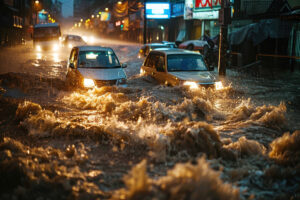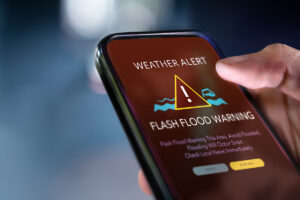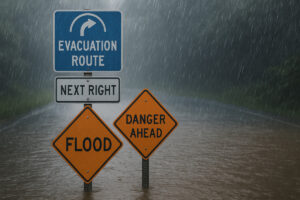July 31, 2025
Tips for Driving in Flood Threat Areas
When we think of floods, we usually think of hurricanes or the build-up of rain over time. However, they can occur for various reasons and are particularly hazardous, especially flash floods. The devastation that took place in Texas over the 4th of July weekend has us all questioning whether there are other ways to prepare for flash flooding or at least have safety procedures in place that might help avoid severe injury. Mother nature waits for no one, and disasters like flash floods happen quickly, making the window to get to safety small. Hurricane season is also in full effect, with increased rainfall and possible flooding, including storm surges, still a possibility. Being knowledgeable about how and why floods occur can help when a route crosses a threatened area.
Why Is Driving in Flood Threat Areas Dangerous?
It is common sense to stay away from places that tend to flood, but for truckers and others who rely on clear roads to complete their jobs, it’s easier said than done. The most dangerous types of floods are flash floods, which can occur in the blink of an eye and destroy everything in their path. Other floods include river floods and storm surges, which can be just as devastating but occur more slowly.

We saw a preview of nature’s wrath and the devastation flash floods can cause at the beginning of this month with the flooding in Texas. The risk of flash floods increases near rivers and streams, as these areas can fill with water within a matter of minutes during heavy rainfall. This is what happened in central Texas over the July 4th weekend, making for one of the most devastating floods ever recorded. The flash floods were a result of a tropical storm that brought heavier rains than expected in a short period. The worst devastation took place along the Guadalupe River, which rose to the size of a small building within a matter of 2 hours, sending tons of water barreling towards everything in sight, taking the lives of more than 140 people, including over 20 children who were attending camp along the river. The power of these floods can lift a semi-truck as if it were a feather, making it crucial never to underestimate the force of water.
Recognizing High Flood Threat Areas
Floods can happen in more ways than one. When we think of floods, we tend to associate them with heavy rains or hurricanes; however, disruptions in the ocean, rapid snowmelt, and the breaking of levees or dams can also cause severe floods. This year’s hurricane season is well underway, and although it’s been relatively quiet on the hurricane front, it’s only the beginning, and we need to be on the lookout for the next couple of months. Hurricanes tend to bring floods in the form of storm surges, which occur more slowly than flash floods, but the amount of water that accumulates can be very deadly and damaging. These surges tend to be worse in cities and areas with more buildings, where there is insufficient land to absorb the water.

Driving in Flood Threat Areas: Do’s and Don’ts
The general rule for encountering a flood risk area while driving is “Turn Around, Don’t Drown.” Over 86% of deaths involving floods are caused by people driving or walking into floodwater without heeding warnings. Safety is always the main priority, and no deadline is worth risking your life. During heavy rain, avoid areas where road work is taking place because these areas contain extra debris that can be washed away, as well as weakened roads. During heavy rainfall predictions, try to stay away from rivers and look for alternate routes that don’t come close to bodies of water, such as lakes, rivers, and streams. These bodies of water are the most dangerous to be around if a flood is imminent.

Hurricane season is in effect until November 30th, making the next couple of months a vital time to be on alert. Preparing ahead will always be one of the best ways to try to ensure a stress-free run. When it comes to floods, the best way to be prepared is to check weather reports along your route before departure and avoid rivers and other bodies of water during heavy rain. Heed the warning signs when posted and remember to Turn Around. Don’t Drown.
Follow our blog for more trucking news and highlights, and check out our employment opportunities and requirements if you are interested in a trucking job.
Other Recommended Readings from Our Blog:
Working the Weather: Driving in the Heat



